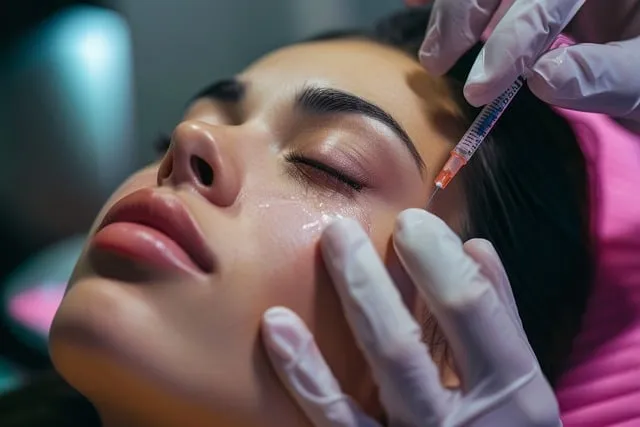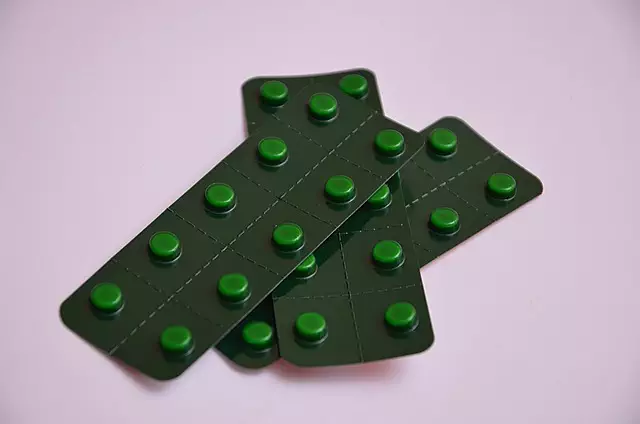Botox treatments have gained popularity as a non-surgical skin tightening solution, addressing the deterioration of collagen and elastin fibers caused by aging, sun damage, smoking, and poor nutrition. By temporarily paralyzing muscles responsible for wrinkles and laxity, Botox restores a more youthful appearance and stimulates collagen production. Other non-invasive methods like radiofrequency (RF) and high-intensity focused ultrasound (HIFU) offer minimal recovery time, no scarring, and precise targeting of problem areas. Prioritizing safety when choosing a qualified provider is crucial; proper post-treatment care includes avoiding strenuous activities, protecting the skin from sunlight, and following aftercare instructions for optimal results and swift recovery. Regular top-up sessions maintain Botox results, lasting 3-6 months with consistent self-care practices.
“Uncover the secrets to achieving a youthful, firm complexion without the need for surgery. This comprehensive guide explores non-invasive skin tightening methods, with a special focus on the transformative power of Botox treatments. From understanding the aging process and its impact on skin elasticity to delving into the science behind Botox stimulation of collagen production, this article is your roadmap to effective, safe, and long-lasting skin rejuvenation. Discover the benefits, potential risks, and expert advice for selecting the right provider, ensuring optimal results.”
Understanding Skin Aging and Relaxed Skin Tissues

The process of skin aging is a complex interplay of various factors, including environmental exposure, lifestyle choices, and genetic predisposition. As we age, our skin undergoes several changes that contribute to its loose and saggy appearance. One of the primary culprits is the degradation of collagen and elastin fibers, which provide structural support and elasticity to our skin. This natural decline can be accelerated by sun damage, smoking, and poor diet, leading to reduced skin firmness and a loss of youthful contour.
Relaxed skin tissues, often associated with aging, occur when the supporting structures of the skin weaken. Collagen, a key protein responsible for skin’s structure and elasticity, becomes less abundant and less effective over time. Additionally, elastin fibers, which help the skin bounce back after stretching, can break down, resulting in permanent sagginess. Botox treatments have emerged as a popular non-surgical solution to address these issues by temporarily paralyzing specific muscles that contribute to wrinkles and skin laxity, offering a more youthful appearance.
Non-Invasive Approaches to Skin Tightening

The quest for achieving a firmer, younger-looking complexion has led many to explore non-invasive skin tightening methods as an alternative to surgery. One popular and well-established option is Botox treatments. These injections work by relaxing specific muscle groups responsible for skin laxity, leading to a more toned and contoured appearance. Beyond its iconic use for facial expression smoothing, Botox has proven effective in reducing the appearance of wrinkles and improving overall skin texture.
Non-invasive procedures offer several advantages, including minimal recovery time, no scarring, and precise targeting of problem areas. In addition to Botox, other emerging techniques like radiofrequency (RF) treatments and high-intensity focused ultrasound (HIFU) are gaining traction. RF technology stimulates collagen production, while HIFU uses targeted sound waves to tighten skin without incisions, providing effective and long-lasting results for those seeking subtle yet noticeable improvements.
The Role of Botox in Collagen Stimulation

Botox treatments have emerged as a popular non-surgical method for skin tightening and rejuvenation. Beyond its well-known ability to temporarily smooth fine lines and wrinkles, Botox plays a surprising role in stimulating collagen production. When injected into specific muscle groups, Botox causes temporary paralysis, which prevents excessive facial movements from breaking down collagen fibers. This process allows the remaining collagen to reorganise and strengthen, resulting in improved skin elasticity and a more youthful appearance.
Additionally, Botox treatments can target areas beyond the face. Neck and body Botox can help reduce the appearance of sagging skin by relaxing muscles that contribute to crepe-like texture and dimpling. This multi-faceted approach makes Botox an appealing option for individuals seeking non-invasive ways to achieve tighter, firmer skin throughout their entire body.
How Botox Treatments Work for Skin Tightening

Botox treatments have emerged as a non-surgical solution for skin tightening, offering significant improvements in facial contouring and reducing the appearance of fine lines and wrinkles. The key to its effectiveness lies in its ability to paralyze or weaken specific muscles responsible for causing creases and folds in the skin. By injecting Botox into these muscle groups, the treatment prevents them from contracting, leading to a smoother and firmer complexion.
Over time, as the muscles relax, the skin takes on a more youthful appearance, appearing tighter and lifted. This cosmetic procedure is particularly popular among individuals seeking a subtle yet noticeable enhancement without undergoing invasive surgery. The non-invasive nature of Botox treatments makes them an appealing option for those wanting to maintain their natural look while achieving a more refined facial structure.
Benefits and Expectations from Non-Surgical Procedures

Non-surgical skin tightening procedures have gained significant popularity due to their numerous benefits and minimal downtime. These treatments offer a more accessible and safer alternative to surgical options, appealing to those seeking youthful-looking skin without incisions. One of the most well-known and effective methods is Botox treatments.
Botox injections can effectively reduce the appearance of fine lines and wrinkles by relaxing specific muscle groups responsible for their formation. Over time, this results in a smoother, more toned complexion. Additionally, non-surgical procedures are often more cost-effective, making them an attractive choice for individuals wanting to enhance their skin’s texture and overall appearance without undergoing surgery.
Safety and Side Effects: What You Need to Know

When considering skin tightening options, it’s crucial to prioritize safety and understand potential side effects. Unlike surgical procedures, non-invasive techniques like Botox treatments offer a safer alternative for those seeking younger-looking skin. However, it’s not without risks; temporary redness, swelling, or discomfort at the injection sites are common. Less frequent but more serious side effects may include allergic reactions, bleeding, or an uneven skin surface. It’s essential to choose a qualified and experienced provider who can minimize these risks and ensure the best possible outcomes.
Before undergoing any treatment, consult with a professional to discuss your medical history and expectations. They will assess your suitability for Botox treatments and guide you on what to expect during and after the procedure. By being well-informed, you can make an educated decision, ensuring both safety and satisfaction with the results.
Choosing the Right Provider for Botox Skin Tightening

When considering Botox skin tightening, selecting the right provider is paramount for achieving optimal results and ensuring safety. It’s essential to look beyond certifications and consider their experience specifically in non-surgical skin tightening treatments. Research their track record, read client testimonials, and inquire about their approach to individualizing treatments based on your unique needs.
Botox treatments are not one-size-fits-all, and a qualified provider will assess your skin’s condition, elasticity, and areas of concern before administering injections. They should offer comprehensive consultations, address any questions or concerns openly, and provide aftercare instructions tailored to promote healing and maximize the benefits of the procedure.
Post-Treatment Care and Recovery Tips

After any skin tightening procedure, including non-surgical options like Botox treatments, proper post-treatment care is essential to achieve optimal results and ensure a swift recovery. The first few days are critical; avoid strenuous activities and extreme temperatures, as these can cause discomfort and potentially affect the healing process. Applying cold compresses to reduce swelling and using gentle, hydrating creams recommended by your dermatologist can aid in minimizing side effects.
Additionally, protecting your skin from direct sunlight is vital, so always use sunscreen. Refrain from makeup application until your skin has completely healed to prevent irritation. Remember, each individual’s recovery journey may vary, so it’s best to follow the aftercare instructions provided by your healthcare professional for the best outcomes.
Long-Term Results and Maintenance Strategies

While immediate results after skin tightening treatments like Botox can be remarkable, understanding long-term outcomes is crucial for setting realistic expectations. Botox, when administered by experienced professionals, offers a non-invasive way to reduce wrinkles and improve skin elasticity. The effects typically last between 3 to 6 months, requiring regular top-up sessions to maintain the desired results. This maintenance strategy is relatively straightforward; it involves periodic treatments tailored to individual needs.
To sustain the long-term benefits, consistent self-care practices are essential. This includes daily sun protection using broad-spectrum sunscreen with at least SPF 30, staying hydrated by drinking ample water, and adopting a balanced diet rich in antioxidants. Additionally, avoiding excessive sun exposure, smoking, and prolonged stress can significantly contribute to preserving the treatment outcomes.



